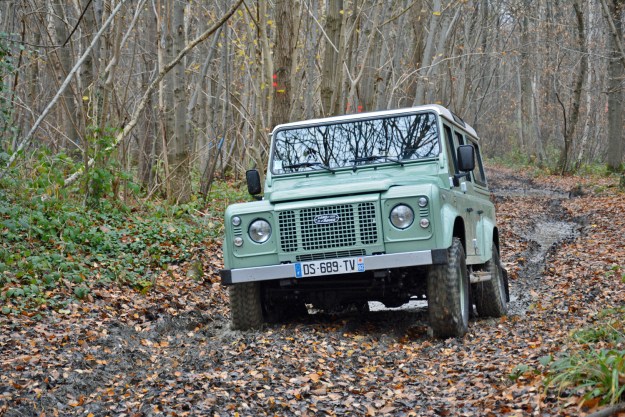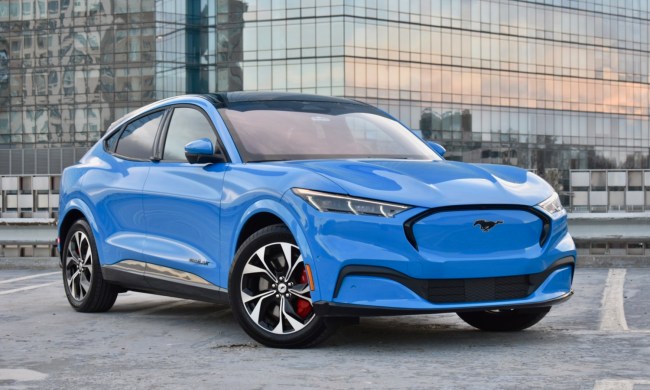
“Rugged, crude, and timeless, the Land Rover Defender is ultimate expression of efficient, function-over-form design.”
- Time-proven design
- Extraordinarily capable off-road
- Well-mannered around town
- Unique on the market
- Out of production
- Outdated interior
Car nameplates are recycled on a regular basis. You can’t buy a new third-generation C-Class anymore, but you can drive home from your local Mercedes-Benz dealership in a vastly improved fourth-generation model that benefits from the latest advances in automotive technology. For three decades, The Land Rover Defender has managed to eschew this evolutionary pattern, so its demise marks the end of an entire era, not just the retirement of a nameplate.
Presented in 1983, the Defender is an icon on four wheels that no longer requires a formal introduction. The version tested here is a 110 (Land Rover-speak for long-wheelbase) Heritage Edition, one of three limited-edition models launched to mark the end of the Defender’s illustrious production run. It stands out thanks to a retro-inspired design with a classic grille, vintage-looking emblems on both ends, body-colored steel wheels, and a two-tone cashmere green/Alaska white paint job. The “HUE 166” decals on the fenders are a reference to the registration number worn by the very first pre-production Series I that was built and registered in 1947.
If it ain’t broke…
Land Rover hasn’t made any mechanical modifications to the Heritage Edition. It’s powered by a stock, Defender-sourced 2.2-liter four-cylinder turbodiesel engine that sends 122 horsepower and a generous 265 pound-feet of torque to all four wheels via a six-speed manual transmission and a two-speed transfer case. The oil-burning four has been the only unit offered for the past couple of years, though the Defender has previously been available with four-, five-, six-, and even eight-cylinder engines.
We need to dispel a myth before we go any further: The rugged Defender shares more than a passing resemblance to the Series I, II, and III models built from the late 1940s to the early 1980s, but the only components it shares with its predecessors are the small retaining plate that helps hold the hood in place and the rear underbody support strut. In other words, it’s not nearly as old as you might think.
That said, its age undeniably shows behind the wheel. It has the turning radius of a Batillus-class supertanker, and it understeers through corners with the body lean of an Airbus A380. At over 82 inches tall, the Heritage model won’t fit in most parking garages, which adds a dash of excitement to an otherwise mundane late-night beer run on the outskirts of Paris, France.
Wellies optional, but recommended
Calling these eccentricities faults would be missing the point entirely. No one’s ever bought a Defender thinking they were getting a supremely comfortable SUV brimming with state-of-the-art gizmos. It doesn’t need an infotainment system with voice commands or wall-to-wall leather upholstery because it has a 48.7-degree approach angle and it can drive through 20 inches of water. It can venture where most other SUVs only dream of going, and that’s more important than any creature comfort for its target audience. It’s built primarily to work, not to strut its stuff at the mall.
Spectacularly rugged, the oldest member of the Land Rover lineup eats SUVs for breakfast and snacks on crossovers.
With permanent four-wheel drive and nearly ten inches of ground clearance, the Defender is extraordinarily capable off the beaten path; it eats SUVs for breakfast and snacks on crossovers. It powers through a foot of mud with surprising aplomb, and it makes rocks and other obstacles routinely encountered on the trail feel like the speed bumps in a 20-mph school zone. The two-speed transfer case helps it soldier on when the going gets really tough. Take one out for a jaunt in the woods and it’ll quickly become obvious why it’s been the vehicle of choice for emergency services and globetrotters for decades. It’s unique on the market because its practical, no-nonsense design has stood the test of time remarkably well.
Job well done
The Defender is surprisingly well-mannered on the tarmac, though the suspension willingly shares every road imperfection with your spine. It’s fast enough to keep up with other cars while pulling away from a stop light and it’ll hold a steady 75 mph on the freeway with no fuss. Driving an older Series III through a small town takes as much effort as riding a bull, but the Defender offers peace of mind in the form of light steering, responsive brakes, and great visibility thanks in part to ultra-thin A-pillars. As an unexpected bonus, it’s so big that motorists trapped in late-model econoboxes are downright afraid of cutting you off or tailgating you. We’ll consider that a passive safety feature. Every little bit helps in a vehicle that’s not fitted with airbags.
When viewed from the outside, the Defender looks like it was teleported from the early 1980s. For better or worse, the same applies to the interior. Sitting behind the wheel is like witnessing a parade of hard plastics and outdated parts such as dinky turn signal stalks that feel like they were pulled out of an Austin Mini. The classic car vibe is further accentuated by the fact that there’s about as much elbow room as you’d find in an air-cooled Volkswagen Beetle. The Defender is crude, but it’s the ultimate expression of efficient, function-over-form design. It’ll effortlessly carry seven passengers from point A to point B, even if there’s a mountain range somewhere in the middle.
Few will be surprised to find out that the assembly process at Land Rover’s Solihull, England, factory has remained roughly the same since the early 1980s. Current members of the Land Rover lineup like the Evoque and the Discovery Sport are built by robots, but the 7,000 individual bits and pieces that make up the Defender are still largely assembled by hand. It consequently takes 56 man hours to build one from start to finish; to put that figure into perspective, building a Discovery Sport takes 48 hours. The painstakingly long production process partially explains why a Defender 110 carries a base price of £27,620, a sum that converts to approximately $40,000, in its home country. The short-wheelbase Defender 90 starts at £25,265, or about $33,200.
Conclusion
There’s one obstacle the Defender can’t tow out of the way or simply drive over: lawmakers. Stringent safety and emissions regulations finally got the best of it, and the last example has rolled off the Solihull assembly line, meaning it’s too late to buy one new. It’s the last of its breed, too. The Mercedes-Benz G-Class has morphed into a $120,000 luxo-barge, the Jeep Wrangler focuses more on leisure than on work, while Lada’s Niva – summed up as a Renault 5 on a Land Rover chassis by USSR officials in the early 1970s – is equally outdated and even more rustic, but not as capable. Even the Toyota Land Cruiser inevitably makes a few concessions in the name of opulence.
A second-generation Defender is coming before the end of the decade but details about what form it will take are vague at best, likely because they haven’t been finalized yet. It might keep the outgoing model’s tough body-on-frame construction, it might not; it might feature a rear-mounted spare tire and throwback round headlights, it might not – only time will tell. What’s certain is that it will have bigger shoes to fill than any new car introduced in recent memory.








